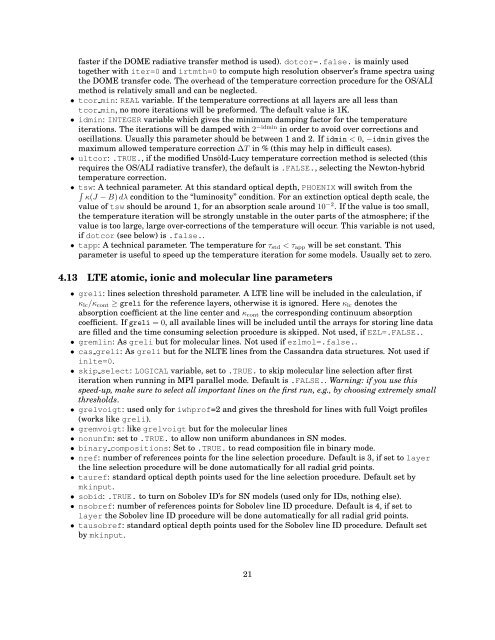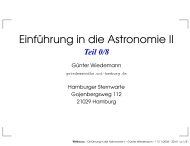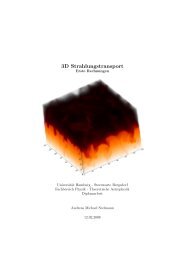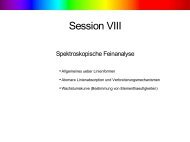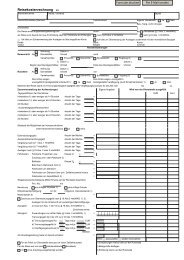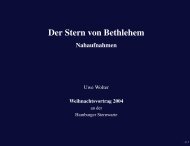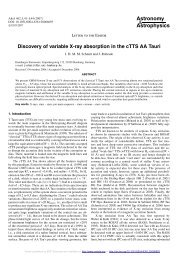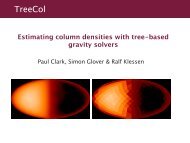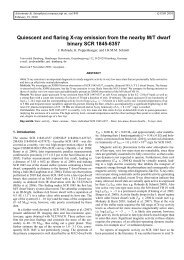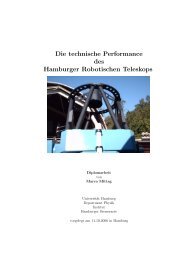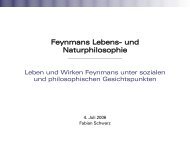Version 15 June 2007 compiled: 11-11-2009 - Hamburger Sternwarte
Version 15 June 2007 compiled: 11-11-2009 - Hamburger Sternwarte
Version 15 June 2007 compiled: 11-11-2009 - Hamburger Sternwarte
You also want an ePaper? Increase the reach of your titles
YUMPU automatically turns print PDFs into web optimized ePapers that Google loves.
faster if the DOME radiative transfer method is used). dotcor=.false. is mainly used<br />
together with iter=0 and irtmth=0 to compute high resolution observer’s frame spectra using<br />
the DOME transfer code. The overhead of the temperature correction procedure for the OS/ALI<br />
method is relatively small and can be neglected.<br />
• tcor min: REAL variable. If the temperature corrections at all layers are all less than<br />
tcor min, no more iterations will be preformed. The default value is 1K.<br />
• idmin: INTEGER variable which gives the minimum damping factor for the temperature<br />
iterations. The iterations will be damped with 2 −idmin in order to avoid over corrections and<br />
oscillations. Usually this parameter should be between 1 and 2. If idmin < 0, −idmin gives the<br />
maximum allowed temperature correction ∆T in % (this may help in difficult cases).<br />
• ultcor: .TRUE., if the modified Unsöld-Lucy temperature correction method is selected (this<br />
requires the OS/ALI radiative transfer), the default is .FALSE., selecting the Newton-hybrid<br />
temperature correction.<br />
• tsw: A technical parameter. At this standard optical depth, PHOENIX will switch from the<br />
� κ(J − B) dλ condition to the “luminosity” condition. For an extinction optical depth scale, the<br />
value of tsw should be around 1, for an absorption scale around 10 −2 . If the value is too small,<br />
the temperature iteration will be strongly unstable in the outer parts of the atmosphere; if the<br />
value is too large, large over-corrections of the temperature will occur. This variable is not used,<br />
if dotcor (see below) is .false..<br />
• tapp: A technical parameter. The temperature for τstd < τapp will be set constant. This<br />
parameter is useful to speed up the temperature iteration for some models. Usually set to zero.<br />
4.13 LTE atomic, ionic and molecular line parameters<br />
• greli: lines selection threshold parameter. A LTE line will be included in the calculation, if<br />
κlc/κcont ≥ greli for the reference layers, otherwise it is ignored. Here κlc denotes the<br />
absorption coefficient at the line center and κcont the corresponding continuum absorption<br />
coefficient. If greli = 0, all available lines will be included until the arrays for storing line data<br />
are filled and the time consuming selection procedure is skipped. Not used, if EZL=.FALSE..<br />
• gremlin: As greli but for molecular lines. Not used if ezlmol=.false..<br />
• cas greli: As greli but for the NLTE lines from the Cassandra data structures. Not used if<br />
inlte=0.<br />
• skip select: LOGICAL variable, set to .TRUE. to skip molecular line selection after first<br />
iteration when running in MPI parallel mode. Default is .FALSE.. Warning: if you use this<br />
speed-up, make sure to select all important lines on the first run, e.g., by choosing extremely small<br />
thresholds.<br />
• grelvoigt: used only for iwhprof=2 and gives the threshold for lines with full Voigt profiles<br />
(works like greli).<br />
• gremvoigt: like grelvoigt but for the molecular lines<br />
• nonunfm: set to .TRUE. to allow non uniform abundances in SN modes.<br />
• binary compositions: Set to .TRUE. to read composition file in binary mode.<br />
• nref: number of references points for the line selection procedure. Default is 3, if set to layer<br />
the line selection procedure will be done automatically for all radial grid points.<br />
• tauref: standard optical depth points used for the line selection procedure. Default set by<br />
mkinput.<br />
• sobid: .TRUE. to turn on Sobolev ID’s for SN models (used only for IDs, nothing else).<br />
• nsobref: number of references points for Sobolev line ID procedure. Default is 4, if set to<br />
layer the Sobolev line ID procedure will be done automatically for all radial grid points.<br />
• tausobref: standard optical depth points used for the Sobolev line ID procedure. Default set<br />
by mkinput.<br />
21


